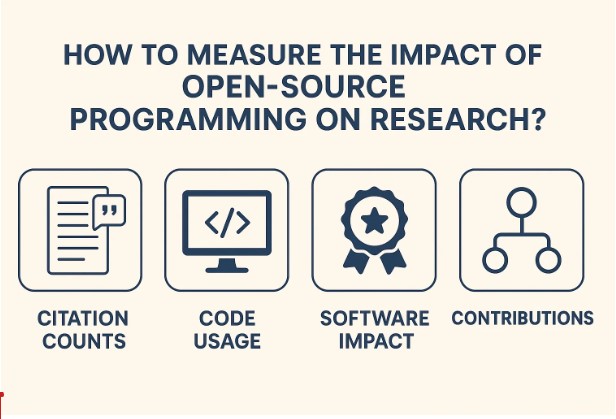How Does Open-Source Programming Affect Research?

How to Measure the Impact of Open-Source Programming on Research?
You may know that open-source programmes are a powerful aspect of modern academic study. It enables you to use, change and distinguish code freely, which enables and speeds up the creativity. When you calculate its influence, it leads you to understand how open tools and teamwork impact academic progress. This may involve checking how open-source code is used and cited in studies. You can also use the supportive tools, like a plagiarism checker free to ensure originality in research work.
Moreover, it helps you show their real value. This guide explores diverse ways to measure the influence of open-source programming and the methods which are used to track its academic significance. Hence, it stresses how open teamwork continues to shape the future of research and education. Scroll below to know more!
Key Metrics for Evaluating Open-Source Contributions in Academia
As you may know that metrics are vital as they help you discover how open-source projects impact academic study. Moreover, they help you understand how widely a tool is used and how it can affect future analysis. Plus, practical measures rely on data and collaborations to measure success. It will also allow you to determine which open-source projects are significant for a particular community. All of these measurable variables help to find projects that enhance learning and innovation, and are applicable to a range of disciplines. The following are different key metrics for assessing open-source contributions in academia.
Citation Impact
Citation impact displays how open-source tools are cited in academic papers. When a research project depends on open-source code, a proper citation enables you to recognise your contribution. Further, tracking citation impacts enables institutes and you to understand how the tool shapes current research. It also promotes fair credit to you and encourages more people to share their work online. In brief, it reflects the academic significance and credibility of open-source contributions. In case, you still face any issue with this concept, you can search for assignment help UK.
Code Reuse
It refers to how a piece of open-source code is used in diverse projects. When you reuse the existing code, it saves you time and reduces errors. This will not only speed up the analysis process but also strengthen teamwork between you and the scientists. Constant reuse means that one is reliable and valuable to others. When you measure code reuse, it aids you in evaluate which tools are practical and potent in academic study. Hence, it is a key indicator of open-source success. If you still have any doubts, feel free to get aid from services like do my assignment for me.
Community Engagement
Do you know what community engagement is? It enables you to gauge how active and involved people are in open-source tasks. Furthermore, it involves discussion, feedback and collaboration between you and the user. You might know that a strong, active community leads to faster problem-solving, better updates, and more reliable tools. It also aids you to recognise which projects have healthy partake and long-term continuity.
Institutional Recognition
It refers to how much colleges, analysis centres and organisations accept open-source contributions. When institutions identify open work, they encourage more transparency and collaboration in research. This recognition can come through funding or academic credit. It also helps you obtain expert value, as you can share your tools & data. Greater institutional support often leads to more innovation, as you feel motivated to create tools that benefit both your fields and the wider community.
Methods and Tools for Assessing Research Impact Through Open Source
You can use several digital methods and tools to measure open-source impact. This may involve tracking citations, analysing repository activity and others. Moreover, surveys and case studies can reveal real-world results of open-source usage in research. With the help of combinations of data-driven tools and qualitative insights, you can get a clear view of how open projects contribute to progress. However, these techniques make it easier to evaluate the actual academic and social value of open-source programming. Below are diverse methods and tools for assessing research impact through open source.
Repository Analysis
You may know that this analysis stresses studying online platforms. Her ripe source is tired and shared. Moreover, it looks at the data, such as the number of contributors, pull requests and more, to understand a project’s popularity and growth. You can see how a project is updated and how many open dependencies are in it. It enables you to measure both technical quality and community interest. Hence, it provides tangible evidence of the project and real work influence. It shows how widely it is used and supported across academic and analysis communities.
Citation Tracking
Citation tracking assists you in locating and determining the frequency with which an open-source project is cited within scholarly taxonomy (i.e. academic papers or articles). It involves searching academic databases, such as Google Scholar or Scopus, that search and quantify references for software tools, code, or datasets. By tracking citations, you can find out which of the myriad open-source projects are having the highest level of impact within academia. Tracking citations is also necessary to ensure that you receive credit for your work. Tracking as well builds transparency and helps facilitate a fair academic recognition system. But citation tracking is a simple and unambiguous way to track scholarly impact within open-source research.
Metric Tools
Metric tools are digital applications that gauge and substantiate the impact of an open-source project. These tools pull quantitative and qualitative metrics based on numerous data points, including downloads, usage rates, contributor activities, and citations. Examples of these applications are Altmetric, Dimensions, and GitHub Insights. The goal of using metric tools is to give researchers a sense of the project’s impact, be it academic or social. A metric tool can save researchers time and provide objective and verifiable results based on factual evidence. By using metric tools, a researcher may use multiple applications to provide a comprehensive view of an open-source project’s reach, impact, and potential sustainability within the field of academia.
Case Studies
As you are aware, case studies provide expanded insights into how open-source projects have impacted real research results. These studies examine specific situations where the use of AI tools improved outcomes. It also saves you time and encourages collaboration. It may involve data analysis, project review and interviews. However, they give a human opinion on the technical data and show how open-source contributions create real academic and social value. You can also learn what works best and how to replicate successful practices.
Final Thoughts
In brief, it has modified how research is done & shared. Open-source planning promotes openness, free flow of thoughts and teamwork. When you measure its impact, it enables you to understand how much open-source tools contribute to academic growth. With the help of metrics like citations, community activity, and adding others, it becomes easier to see how open tasks enable innovation and collaboration.
Institutions and researchers benefit when they recognise the importance of open contributions, as this motivates others to share their work too. In this process, you can also use supportive resources, such as a plagiarism checker free can help maintain integrity in shared research. In this way, you can contribute to building a transparent and cooperative environment. Here, it is more than just a stare. It enables you to represent a culture of sharing knowledge and improving ideas together.



